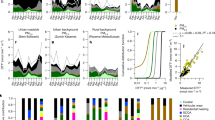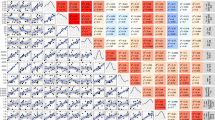Abstract
We derive general-purpose mathematical model for pollution concentration studies. The model is based on the aerosol general dynamic equation (GDE). It accounts for aerosol processes like coagulation and growth by deposition and is therefore suited for suspended-particle monitoring. Our model is validated by controlled experiments done using standard aerosol monitoring devices that measure PM10, particle cross section, particle-bound polycyclic aromatic hydrocarbons (PPAHs) and number concentration, showing an excellent agreement with the experimental data in a 77-m3 room with a time sequence of cigarettes smoked. As an example of an application, we calculated the mean PPAH emission rate in environmental tobacco smoke (ETS) for a “smolder-smoked” cigarette and found it to be 8 ng/s for a total emission of 5.28 μg per cigarette. The results show that real aerosol dynamics should be taken into account when monitoring suspended particles.
This is a preview of subscription content, access via your institution
Access options
Subscribe to this journal
Receive 6 print issues and online access
$259.00 per year
only $43.17 per issue
Buy this article
- Purchase on Springer Link
- Instant access to full article PDF
Prices may be subject to local taxes which are calculated during checkout



Similar content being viewed by others
Notes
For detailed assumptions and experimental validation of the mass balance method, refer to Ott et al. (1992).
References
Bömmel, H, Li-Weber, M, Serfling, E, and Duschl, A . The environmental pollutant pyrene induces the production of IL-4. J Allergy Clin Immunol (2000) 105(4)796–802
Brauer, M, Hirtle, R, Lang, B, and Ott, W . Assessment of indoor fine aerosol contributions from environmental tobacco smoke and cooking with portable nephelometer. J Exposure Anal Environ Epidemiol (2000) 136–144
Burtscher, H, and Siegmann, HC . Monitoring PAH-emissions from combustion processes by photoelectric charging. Combust Sci Technol (1994) 101: 327–332
Denissenko, MF, Pao, A, Tang, M, and Pfeifer, GP . Preferential formation of benzo[a]pyrene adducts at lung cancer mutational hotspots in p53. Science (1996) 274: 430
Dubowsky, S, Wallace, LA, and Buckley, TJ . The contribution of traffic to indoor concentrations of polycyclic aromatic hydrocarbons. J Exposure Anal Environ Epidemiol (1999) 9: 312–321
Friedlander, SK . Smoke, Dust, Haze. Oxford University Press, New York 2000
Godleski, JJ, Sioutas, C, Katler, M, and Koutrakis, P . Inhalation of concentrated ambient air particles in animal models of pulmonary disease. Proceedings of the 2nd Colloquium on Particulate Air Pollution and Human Health vol. 4 1996 pp. 136–143
Kasper, M, Keller, A, Paul, J, Siegmann, K, and Siegmann, HC . Photoelectron spectroscopy without vacuum: nanoparticles in gas suspension. J Electron Spectrosc Relat Phenom (1999) 98–99: 83–93
Keller, A, and Siegmann, K . Effects of second-order processes in aerosol monitoring. J Aerosol Sci (2001) 32: 1235–1247
Klepeis, NE, Ott, WR, and Switzer, P . A multiple smoker model for predicting indoor air quality in public lounges. Environ Sci Technol (1996) 30(9)2813–2820
Leuenberg, P et al. Swiss study on air pollution and lung diseases in adults. Final Report to the Swiss Nat. Res. Foundation (1995
Ott, W, Langan, L, and Switzer, P . A time series model for cigarette smoking activity patterns: model validation for carbon monoxide and respirable particles in a chamber of an automobile. J Exposure Anal Environ Epidemiol (1992) 2 (suppl 2) 175–200
Ott, W, Wilson, N, Klepeis, N, and Switzer, P . Real-time monitoring of polycyclic aromatic hydrocarbons and respirable suspended particles from environmental tobacco smoke in a home. Proceedings of the International Symposium, Measurement of toxic and Related air Pollutants, Durham, NC, Report No. VIP-39, Air and Management Association, Pittsburgh, PA, NTIS PB-94-20956 (1994)
Qian, Z, Siegmann, K, Keller, A, Matter, U, Scherrer, L, and Siegmann, HC . Nanoparticles air pollution in mayor cities and its origin. Atmos Environ (2000) 34: 443–451
Weingartner, E, Keller, C, Stahel, WA, Burtscher, H, and Baltensperger, U . Aerosol emission in a road tunnel. Atmos Environ (1997) 31: 451–462
Acknowledgements
We thank W. Ott for suggesting this project and for the interesting and helpful discussions. A. Keller acknowledges CONACyT for support.
Author information
Authors and Affiliations
Corresponding author
Rights and permissions
About this article
Cite this article
KELLER, A., SIEGMANN, H. The role of condensation and coagulation in aerosol monitoring. J Expo Sci Environ Epidemiol 11, 441–448 (2001). https://doi.org/10.1038/sj.jea.7500187
Received:
Published:
Issue Date:
DOI: https://doi.org/10.1038/sj.jea.7500187



